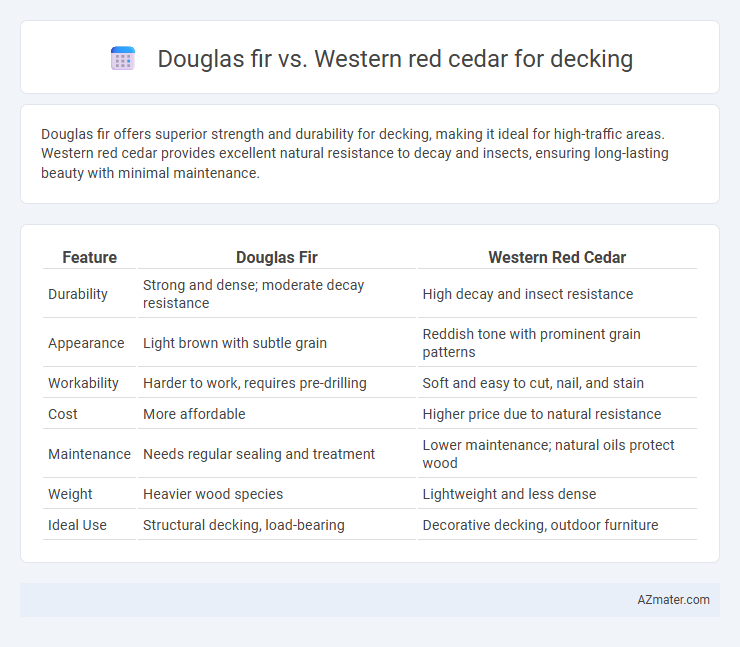Douglas fir offers superior strength and durability for decking, making it ideal for high-traffic areas. Western red cedar provides excellent natural resistance to decay and insects, ensuring long-lasting beauty with minimal maintenance.
Table of Comparison
| Feature | Douglas Fir | Western Red Cedar |
|---|---|---|
| Durability | Strong and dense; moderate decay resistance | High decay and insect resistance |
| Appearance | Light brown with subtle grain | Reddish tone with prominent grain patterns |
| Workability | Harder to work, requires pre-drilling | Soft and easy to cut, nail, and stain |
| Cost | More affordable | Higher price due to natural resistance |
| Maintenance | Needs regular sealing and treatment | Lower maintenance; natural oils protect wood |
| Weight | Heavier wood species | Lightweight and less dense |
| Ideal Use | Structural decking, load-bearing | Decorative decking, outdoor furniture |
Introduction: Douglas Fir vs Western Red Cedar for Decking
Douglas fir and Western red cedar are two popular choices for decking materials, each offering distinct benefits in durability and appearance. Douglas fir features high strength and a tight grain pattern, making it ideal for structural use and long-lasting decking under heavy foot traffic. Western red cedar provides natural resistance to rot and insects, along with rich color and aroma, making it a favored option for aesthetically pleasing, low-maintenance outdoor spaces.
Wood Characteristics: Appearance and Grain
Douglas fir decking features a straight, pronounced grain with a warm, reddish-brown hue that darkens with age, offering a classic, rustic appeal. Western red cedar showcases a rich reddish tone with a fine, uniform grain pattern and natural knots that contribute to its distinctive, elegant appearance. Both woods provide aesthetic versatility, but Douglas fir tends to exhibit a more linear and textured grain compared to the smoother, more consistent grain of Western red cedar.
Durability and Lifespan Comparison
Douglas fir offers a durability rating of moderate to high with a typical lifespan of 15 to 25 years when properly maintained, making it resistant to decay but more prone to insect damage than Western red cedar. Western red cedar is naturally resistant to rot, decay, and insect attacks, providing superior longevity often exceeding 30 years, which contributes to its premium status for decking in damp or coastal climates. Both species require regular sealing or staining to maximize durability, but cedar's inherent oils give it a significant edge in lifespan and weather resistance without heavy chemical treatments.
Resistance to Weather, Decay, and Insects
Douglas fir offers strong resistance to weather and structural strength but requires treatment to improve decay and insect resistance, making it less naturally durable than Western red cedar. Western red cedar contains natural oils and tannins that provide superior resistance to moisture, decay, and insect damage, making it an excellent choice for outdoor decking in harsh climates. Its inherent durability extends the lifespan of decking without frequent chemical treatments, ensuring long-lasting performance in exposed environments.
Maintenance Requirements for Each Wood Type
Douglas fir decking demands regular sealing and staining to protect against moisture, UV damage, and insect infestation due to its moderate natural durability. Western red cedar requires less frequent maintenance because of its natural oils and tight grain that resist rot, decay, and insect attacks, often needing only annual cleaning and occasional staining to maintain its appearance. Both woods benefit from proper airflow and drainage to extend lifespan, but Western red cedar generally offers lower long-term maintenance costs compared to Douglas fir.
Cost Differences: Initial Investment and Long-Term Value
Douglas fir decking typically has a lower initial cost compared to Western red cedar, making it a budget-friendly choice for many homeowners. However, Western red cedar offers superior natural resistance to decay and insect damage, reducing long-term maintenance expenses and extending the lifespan of the deck. Investing in Western red cedar may result in higher upfront costs but delivers greater durability and overall value over time.
Workability: Cutting, Fastening, and Finishing
Douglas fir offers excellent workability with easy cutting, strong nail and screw holding power, and a smooth finish that accepts stains and paints well. Western red cedar is softer and easier to cut, providing good fastening capabilities, though pre-drilling may be needed to prevent splitting. Its fine grain and natural tannins enhance finishing by promoting even stain absorption and long-lasting protection.
Environmental Impact and Sustainability
Douglas fir offers strong durability and fast growth rates, making it a more sustainable choice due to its ability to replenish quickly and reduce logging pressure. Western red cedar is naturally resistant to decay and insect damage, requiring less chemical treatment, which benefits environmental health but grows slower and may have a higher ecological footprint per board foot. Both species are available from certified sustainable sources like FSC, but Douglas fir's faster regeneration cycle gives it an edge in minimizing long-term environmental impact for decking projects.
Best Applications: When to Choose Douglas Fir or Western Red Cedar
Douglas fir's superior strength and durability make it ideal for structural decking applications requiring heavy load-bearing capacity and long-lasting support, especially in areas exposed to varying weather conditions. Western red cedar excels in aesthetic appeal and natural resistance to decay and insects, making it a top choice for decorative or residential decking where moisture resistance and a rich, warm finish are priorities. Choose Douglas fir for high-traffic, structural decks and Western red cedar for visually appealing, low-maintenance decks in humid or coastal environments.
Conclusion: Which Wood Is Better for Your Deck?
Douglas fir offers superior strength and durability, making it ideal for high-traffic decks requiring long-lasting performance. Western red cedar provides excellent natural resistance to decay and insect damage, along with a distinctive rich color that enhances aesthetic appeal. Choosing between the two depends on prioritizing structural strength with Douglas fir or natural weather resistance and visual warmth with Western red cedar.

Infographic: Douglas fir vs Western red cedar for Decking
 azmater.com
azmater.com